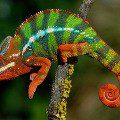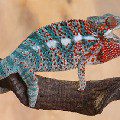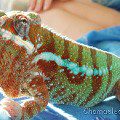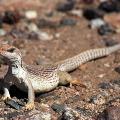
Panther chameleon
Chameleons have attracted people since ancient times. In the cultures of different peoples, there are many legends and myths about them. And, of course, in these legends the main ability of lizards is sung – to change color depending on the surrounding conditions and internal state. But, despite the clear separation of chameleons from a number of reptiles, our knowledge about them is, in fact, quite scarce. For example, the reason for the transformation of these lizards is not only disguise, but also the ability to communicate with each other through color changes. And besides her, chameleons have many other amazing abilities, for example, the rotation of the eyes in different directions independently of each other or the amazing accuracy of the “shot” with the tongue while hunting insects.
Contents
Classification
Kingdom: Animals
Type: Chord
Class: Reptiles
Order: Scaly
Suborder: Lizards
Family: Chameleons
Genus: Real chameleons
Species: Panther Chameleon, Furcifer Pardalis
Appearance
 The panther chameleon is a fairly large lizard. Males are able to grow up to 50 cm, and females up to 35 cm. The sides of their bodies are decorated with a fancy spotted pattern of various shapes. The head of the lizards is wide, “equipped” with a helmet of two petal-shaped outgrowths. The more convex this helmet, the stronger the lizard is considered. The crest on its back is a dense spiked “palisade”, noticeably shortening towards the tail. The coloration of panther chameleons, especially males, is extremely diverse. Zoologists distinguish several stable color forms within the same range. The dominant colors are usually green, blue or red. The spots on the sides are also reddish, bluish or brown, sometimes separated by a white intermittent stripe. Female panther chameleons are usually orange or beige, adorned with vertical dark stripes. The body of young lizards has a light beige with green or yellow tint. Because of the combination of orange and black and spotted-striped pattern, these chameleons got their name, indicating their resemblance to large predators. True, this similarity is limited. However, within this single species, perhaps the greatest variety of coloration is found.
The panther chameleon is a fairly large lizard. Males are able to grow up to 50 cm, and females up to 35 cm. The sides of their bodies are decorated with a fancy spotted pattern of various shapes. The head of the lizards is wide, “equipped” with a helmet of two petal-shaped outgrowths. The more convex this helmet, the stronger the lizard is considered. The crest on its back is a dense spiked “palisade”, noticeably shortening towards the tail. The coloration of panther chameleons, especially males, is extremely diverse. Zoologists distinguish several stable color forms within the same range. The dominant colors are usually green, blue or red. The spots on the sides are also reddish, bluish or brown, sometimes separated by a white intermittent stripe. Female panther chameleons are usually orange or beige, adorned with vertical dark stripes. The body of young lizards has a light beige with green or yellow tint. Because of the combination of orange and black and spotted-striped pattern, these chameleons got their name, indicating their resemblance to large predators. True, this similarity is limited. However, within this single species, perhaps the greatest variety of coloration is found.
The transformation of panther chameleons, like other representatives of the class, depends on the ambient temperature, mood, condition, and even the background near which the reptiles are located. Their bizarre appearance is complemented by spikes on the throat thickening, the upper part of the muzzle enlarged from the sides and large scales in this area in males. Panther chameleons are rather well-fed creatures in appearance, their guttural sac resembles a rounded goiter, and in general their forms are quite streamlined. Bulging large eyes stand out on the head, almost completely covered with leathery eyelids, opening only the pupils. This organ of vision in chameleons has a special property, like a periscope, to rotate in different directions independently of each other. The scales of lizards are convex, and when the color changes, they are different, even the smallest scales can be folded into bizarre patterns on their body.
But, alas, these beauties do not live very long – in nature 2, and in the terrarium 4 years. However, terrariumists still love and appreciate these lizards. Most often in the collections there is a species of panther chameleons brought from the island of Nosy Be. If you are accidentally offered to buy a nondescript dark gray or brown reptile, do not rush to accuse the seller of cheating. Most likely, this is still a young representative of the species. Panther chameleons acquire bright colors when they reach 6-9 months. Characteristic of lizards and sexual dimorphism. Males differ from females in their large size, greater brightness of colors and thickened tail base.
Distribution and habitation
 Panther chameleons are characteristic of the northern and eastern territories of the island of Madagascar and the nearby islands of Nosy Be, St. Mary, Nosy Mangaben, Nosy Buraha, Nosy Tanikeli, as well as Mauritius and Reunion. They are easiest to meet in coastal areas with high temperatures (25-28o C during the day, 4-6o C lower at night) and high humidity (between 70 and 100%). Lizards and people do not shy away, settling near residential buildings and cultural plantations. They usually live on trees and shrubs of various heights. The climate of Madagascar is characterized by seasonal changes and high levels of precipitation in the summer – and this suits the reptile quite well. So it is desirable for her to provide similar conditions in the terrarium. In particular, a fountain installed in it will help to maintain high humidity at all times. In general, panther chameleons manifest themselves as a species that is much more resistant to external influences. For example, if the forests that are part of the habitat of reptiles are plowed up, then chameleons immediately settle in the spaces formed as a result, displacing representatives of other species that previously lived here.
Panther chameleons are characteristic of the northern and eastern territories of the island of Madagascar and the nearby islands of Nosy Be, St. Mary, Nosy Mangaben, Nosy Buraha, Nosy Tanikeli, as well as Mauritius and Reunion. They are easiest to meet in coastal areas with high temperatures (25-28o C during the day, 4-6o C lower at night) and high humidity (between 70 and 100%). Lizards and people do not shy away, settling near residential buildings and cultural plantations. They usually live on trees and shrubs of various heights. The climate of Madagascar is characterized by seasonal changes and high levels of precipitation in the summer – and this suits the reptile quite well. So it is desirable for her to provide similar conditions in the terrarium. In particular, a fountain installed in it will help to maintain high humidity at all times. In general, panther chameleons manifest themselves as a species that is much more resistant to external influences. For example, if the forests that are part of the habitat of reptiles are plowed up, then chameleons immediately settle in the spaces formed as a result, displacing representatives of other species that previously lived here.
Behavior and lifestyle
 Have you ever wondered why a chameleon changes color? For some, the obvious answers to it will be: the lizard is scared, sick, or in disguise. But the reasons for the transformation of the panther chameleon are not limited to this. By changing color, body shape and making special movements at a certain point in time, the lizard signals to its relatives about certain intentions – readiness for protection or reproduction, aggression or friendliness. The reptile for which such a signal is intended usually responds with appropriate signs. And of course, in terms of camouflage, hardly anyone can compare with panther chameleons. They can remain in a state of immobility for a long time, painted in the color of the environment, so that it is not possible to distinguish them from a branch or any leaf. And if a bright flash accidentally flashed among the greenery, then, most likely, these are male chameleons dividing the territory, competing with each other in the brightness of colors. So panther lizards are by nature solitary. In terrariums, they are planted together only for mating and not for long, otherwise the reptiles can injure each other. Especially often females show aggressiveness towards young inexperienced males. Panther chameleons are generally incredibly mobile, unlike other species. When they feel danger, they try to confuse the enemy not only with the help of coloring, but also moving around in seemingly aimless jumps. So these lizards need a spacious terrarium for a normal life.
Have you ever wondered why a chameleon changes color? For some, the obvious answers to it will be: the lizard is scared, sick, or in disguise. But the reasons for the transformation of the panther chameleon are not limited to this. By changing color, body shape and making special movements at a certain point in time, the lizard signals to its relatives about certain intentions – readiness for protection or reproduction, aggression or friendliness. The reptile for which such a signal is intended usually responds with appropriate signs. And of course, in terms of camouflage, hardly anyone can compare with panther chameleons. They can remain in a state of immobility for a long time, painted in the color of the environment, so that it is not possible to distinguish them from a branch or any leaf. And if a bright flash accidentally flashed among the greenery, then, most likely, these are male chameleons dividing the territory, competing with each other in the brightness of colors. So panther lizards are by nature solitary. In terrariums, they are planted together only for mating and not for long, otherwise the reptiles can injure each other. Especially often females show aggressiveness towards young inexperienced males. Panther chameleons are generally incredibly mobile, unlike other species. When they feel danger, they try to confuse the enemy not only with the help of coloring, but also moving around in seemingly aimless jumps. So these lizards need a spacious terrarium for a normal life.
Panther chameleons stand apart from other members of the family. In terms of the brightness of the “outfits”, any other species is unlikely to be able to compete with them. Perhaps this is what made panther chameleons such popular pets. This type of lizard can be found in the collection of both an experienced and a novice terrariumist, since caring for reptiles is not difficult. They are distinguished by good health and friendliness towards humans. Panther chameleons quickly get used to the hands and easily make contact. They are interesting to watch, easy to feed and not difficult to create suitable conditions for reproduction. In general, these are pleasant pets in all respects.
Food
The main food of panther chameleons is various invertebrates and newborn rodents. Particularly large individuals can hunt small lizards and even gaping birds in the trees. Hunting chameleons is peculiar. Lizards are patient and can wait hours for prey in ambush, disguising themselves as a piece of wood or a leaf. When it falls within the reach of the chameleon, it immediately throws out its tongue, at the end of which there is a special adhesive substance, and with its help it just as quickly pulls the victim into its mouth. But chameleons chew food slowly and slowly. Sometimes reptiles eat their own offspring. Herpetologists recommend feeding them every other day with various insects – crickets, flies, locusts, grasshoppers, cockroaches. Food for panther chameleons should be bred on their own, sometimes adding wild-caught insects to the diet. Pieces of sweet fruits and succulent leaves of house plants will help diversify the diet of lizards. Sometimes you should arrange fasting days for your pet, since the voracity of lizards sometimes leads to excess weight. If the chameleon suddenly refused to take food and stopped opening its mouth, it is enough to lightly tap on the tip of its nose or touch the eye sockets. Moisture lizards need very little, they can be watered from a pipette a couple of times a week. And, of course, we must not forget about mineral supplements and vitamins. Especially useful for panther chameleons is calcium, the powder of which can be sprinkled on any food. Liquid multivitamins can be fed to reptiles, as well as water, by pipetting at least once a week, and also added to water by spraying.
Reproduction
Panther chameleons are considered quite aggressive creatures, however, not the same as their Yemeni relatives. However, keeping a male and female in the same terrarium is not recommended except for mating purposes. And it begins in chameleons with a mating ritual, when the male especially enhances the brightness of his color and approaches the chosen one with nods of his head. If the girl is ready to reciprocate, then she calmly expects this approach, fixing herself more tightly on the branch. And if not ready, then she responds to the courtship of the male with an arched back, hissing and warning attacks. In this case, the male leaves the chosen one, waiting for better times.
For mating, the panther chameleon climbs onto the female and pushes her several times, after which she raises her tail, demonstrating her readiness. Copulation time is about half an hour. Moreover, the female remains ready for mating for another 3 days. However, with the incipient pregnancy, she turns into a nervous and voracious creature, changing her usual color to chocolate or even black with pink spots. Pregnancy lasts up to 2 months, and then the egg-laying panther chameleon begins to prepare the nest. To do this, he digs a hole in the moist substrate and makes a clutch of 12 to 46 eggs, dropping them in two-thirds. Two weeks later, the female is ready to conceive again. The incubation period for panther chameleons lasts almost 9 months, and it also captures the winter season, so that in an artificial incubator, lizards imitate wintering with a decrease in temperature. If everything goes smoothly, then at the right time, small, pale chameleons with a barely noticeable pattern will appear. Panther chameleon babies born into the world should be fed with water, tiny crickets and fruit flies, as well as vitamin and mineral supplements.
Sources of
http://chamaeleon.ru/
http://www.floranimal.ru
http://www.magazin-priroda.ru
http://www.pitomec.ru/





